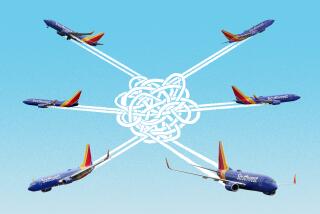A Fluctuating Altimeter
- Share via
How much loft is left for airline stocks?
Shares of most major U.S. carriers are up nicely this year as the airlines continue to enjoy robust passenger traffic and higher average fares. And they’ve done so while overcoming rising fuel prices, concerns about an economic slowdown, labor unrest at AMR Corp.’s American Airlines unit and investors’ ever-present suspicion that the airlines will revert to traditional form and somehow botch their current prosperity.
The American Stock Exchange’s index of 10 airline stocks has risen 12% so far in 1997, triple the 4% increase of the Standard & Poor’s 500 index. The airlines are also a key reason why the Dow Jones transportation index hit a record high of 2,580.55 last week.
But this year’s first few months don’t tell the whole story. The stocks are recapturing ground they lost last summer when fuel prices spiked upward, and they’re actually trailing the market for the last 12 months. The Amex’s index, for instance, is up 8% for the last year compared with the 18% surge in the S&P; 500.
Much of this year’s charge is being led by Delta Air Lines Inc. (ticker symbol: DAL); UAL Corp. (UAL), the parent of industry leader United Airlines, and US Airways Group Inc. (U), the old USAir Group that’s improved substantially from two years ago when it was teetering close to bankruptcy.
As for other airline stocks, Wall Street has a decidedly mixed view of their prospects for the rest of 1997--and it shows in their prices.
Northwest Airlines Corp. (NWAC), currently at $37.75 a share, is down slightly so far this year, and it warned last week that it doesn’t expect fuel prices to drop noticeably throughout 1997. That prompted Dillon Read & Co. analysts Edward Starkman and John Pincavage to remove their “buy” recommendation on the stock.
Southwest Airlines Co. (LUV)--the short-haul carrier that has long been a Wall Street favorite for its consistent profitability--is up 23% for the year to a recent $27 a share. Last week, it said first-quarter earnings soared 54% from a year earlier, and analysts Brian Harris of Lehman Bros. and James Higgins of Donaldson, Lufkin & Jenrette Securities raised their ratings of Southwest to a “buy.”
But analysts also fret that Southwest, known for charging low prices, will struggle to offset the higher fuel costs unless it raises fares. In the first quarter, Southwest paid a whopping 21% more for fuel than it did a year earlier. Also, Southwest continues to spend heavily on expanding its route network along the East Coast.
*
As for the industry overall, fuel prices are still stubbornly high, potential labor problems still loom at some airlines and fears of a slowing economy are as strong as ever.
Also, the airlines remain true to form and are saddled with considerable debt--debt that can become crushing if the economy sours and passengers don’t fly as much--even though they’ve worked hard to use some of their big profits of the past two years to reduce the leverage on their balance sheets.
*
Yet certain carriers continue to be recommended by analysts, in good part because the airlines’ managements--as the debt-reduction actions show--have demonstrated that they’re much more willing to avoid the mistakes of the past, what Goldman Sachs & Co. called “their self-destructive tendencies” in a recent report.
That means the carriers are showing more restraint. They aren’t rapidly expanding their fleets or their route networks, are not amassing mountains of fresh debt and are not engaging in suicidal price wars all over the country merely because they’ve turned solid profits for the past 18 months.
One of Wall Street’s current favorites is Continental Airlines Inc. (CAI/B), which is flying high after making a stunning comeback from two trips to Bankruptcy Court. The stock is up 9% this year.
Houston-based Continental is being touted by Harris and other analysts because the airline’s traffic and yields (that is, its average ticket prices) remain strong.
That’s partly because Continental’s improved service is attracting more business travelers who, on average, pay higher prices for seats. Continental is also flying fuller planes, which helped the airline post first-quarter earnings that exceeded Wall Street’s forecasts.
But there could be turbulence ahead for Continental. Its pilots, which just opened negotiations with the airline on a new contract, are itching for a substantial pay hike, yet Continental is committed to keeping its costs as low as possible.
*
As for industry bellwether UAL, its stock jumped to a 52-week high of nearly $81 a share after the company last week posted first-quarter earnings that exceeded analysts’ forecasts. Analyst Julius Maldutis of Salomon Bros. raised his opinion of the Chicago-based carrier to “buy” from “hold.”
Yet UAL then fell back to about $75 on Monday after some other analysts, Kevin Murphy of Morgan Stanley & Co. among them, said UAL’s price no longer made it an attractive buy.
Regardless, Salomon’s Maldutis is among the most bullish of airline observers, with “buy” ratings on several carriers including AMR, Northwest and Delta, along with some regional airlines, such as Milwaukee-based Midwest Express Holdings Inc. (MEH) and Cincinnati-based Comair Holdings Inc. (COMR).
Dillon Read’s Starkman and Pincavage also like Reno Air Inc. (RNO), which is rebounding after flooding in Nevada led to scores of canceled flights and a first-quarter loss of $5 million.
Maldutis also touts AMR even though American Airlines has yet to ink a new contract with its pilots, and the delay is a key reason why AMR is up only 2% so far this year. The pilots briefly struck American--the second-biggest U.S. carrier behind United--in mid-February before President Clinton stepped in, and the pilots are about to vote on a new tentative pact reached between American and the Allied Pilots Union.
US Airways also exemplifies the skittish feeling about the airlines’ outlook. The stock--despite surging 31% so far this year, to a recent $30.50 a share--is still being touted by some analysts, especially after the company reported a first-quarter profit of $153 million, a record for the airline, last week.
Yet clouds are gathering over US Airways too. Analysts agree the carrier must slash its costs further to be more competitive, but the airline is struggling to reach cost-saving contracts with its unions. And while announcing its strong first quarter, US Airways disclosed that it “nevertheless continues to experience significant losses in key markets” and that it was even mulling “becoming a smaller, regional carrier.”
Wall Street generally remains neutral about ailing Trans World Airlines (TWA), even though there are signs that the airline--which is still reporting big losses in spite of the industry’s prosperity--is improving. Its stock, at $7.25 a share, is up 10% this year but still down 59% for the past 12 months.
Times staff writer James F. Peltz can be reached at james.peltz@latimes.com
(BEGIN TEXT OF INFOBOX / INFOGRAPHIC)
Change in the Air?
Airline stocks as a whole are easily outpacing the broader market this year, but there’s concern about the shares’ staying power. Here are some of the players:
*--*
% change in price Stock Ticker Recent from Jan. 1 US Airways U $30.50 +31% Delta DA L 90.25 +27 Southwest LUV 27.00 +23 UAL (United) UAL 75.50 +21 Alaska Air Group ALK 25.25 +19 Continental/Class B CAI/B 31.00 +9 AMR (American) AMR 90.00 +2 America West Holdings AWA 15.75 --2 Northwest NWAC 37.75 --4 Amex Airline Index +12 Standard & Poor’s 500 +4
*--*
Source: Bloomberg News
More to Read
Inside the business of entertainment
The Wide Shot brings you news, analysis and insights on everything from streaming wars to production — and what it all means for the future.
You may occasionally receive promotional content from the Los Angeles Times.











